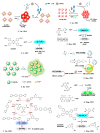Zinc (II) and AIEgens: The "Clip Approach" for a Novel Fluorophore Family. A Review
- PMID: 34299451
- PMCID: PMC8304007
- DOI: 10.3390/molecules26144176
Zinc (II) and AIEgens: The "Clip Approach" for a Novel Fluorophore Family. A Review
Abstract
Aggregation-induced emission (AIE) compounds display a photophysical phenomenon in which the aggregate state exhibits stronger emission than the isolated units. The common term of "AIEgens" was coined to describe compounds undergoing the AIE effect. Due to the recent interest in AIEgens, the search for novel hybrid organic-inorganic compounds with unique luminescence properties in the aggregate phase is a relevant goal. In this perspective, the abundant, inexpensive, and nontoxic d10 zinc cation offers unique opportunities for building AIE active fluorophores, sensing probes, and bioimaging tools. Considering the novelty of the topic, relevant examples collected in the last 5 years (2016-2021) through scientific production can be considered fully representative of the state-of-the-art. Starting from the simple phenomenological approach and considering different typological and chemical units and structures, we focused on zinc-based AIEgens offering synthetic novelty, research completeness, and relevant applications. A special section was devoted to Zn(II)-based AIEgens for living cell imaging as the novel technological frontier in biology and medicine.
Keywords: AIE; fluorescence; zinc complex.
Conflict of interest statement
The authors declare no conflict of interest.
Figures











References
-
- Langhals H. Fluorescence and fluorescent dyes. Phys. Sci. Rev. 2020;5:1–26. doi: 10.1515/psr-2019-0100. - DOI
-
- Valeur B., Berberan-santos N. Emergence of Quantum Theory. J. Chem. Educ. 2011;88:731–738. doi: 10.1021/ed100182h. - DOI
-
- Concilio S., Ferrentino I., Sessa L., Massa A., Iannelli P., Diana R., Panunzi B., Rella A., Piotto S.P. A novel fluorescent solvatochromic probe for lipid bilayers. Supramol. Chem. 2017;29:887–895. doi: 10.1080/10610278.2017.1372583. - DOI
Publication types
MeSH terms
Substances
LinkOut - more resources
Full Text Sources

